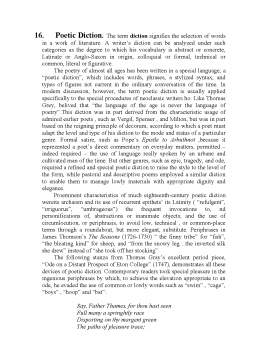Extras din seminar
1. Hiperbole and understatement= the figure of speech called hyperbole( Greek for “overshooting”) is bold overstatement ,or extravagant exaggeration of fact, used either for serious or comic effect. Iago says gloatingly of Othello (III. Iii 330 ff.):
Not poppy nor mandragora,
Nor all the drowsy syrups of the world,
Shall ever medicine thee to that sweet sleep
Which thou ow’dst yesterday.
See also Ben Jonson’s gallantly hyperbolic compliments to his lady in “ Drink to me only with eyes”, and the ironic hyperboles in “ To His Coy Mistress”, by witch Marvell attests how slow his “ vegetable love should grow”- if he had “but world enough and time”. The “talk talk” and “tall tale” of the American West is a form of comic Hyperbole. ( There is the story of a cowboy in a Eastern restaurant who ordered a steak well done. “Do you call this well done?” he roared at the waitress. “I’ve seen critters hurt worse than that get well!”)
The contrary figure is understatement( the Greek term is meiosis, “lessening”) which deliberately represents something as mush less in magnitude or importance than it really is. The effect is usually ironic- savagely ironic in Swifts’s A Tale of a Tub, “ Last week I saw a woman flayed, and you will hardly believe how much it altered her person for the worse”, and comically ironic in Mark Twain’s comment: “The reports of my death are greatly exaggerated”.( See Irony) Some critics extend “meiosis” to the use in literature of an utterly simple, unemphatic statement to enhace the effect of a pathetic or tragic event: an exalmple is the line at the close of the narrative in Wordsworth’s Michael: “ And never lifted up a single stone”.
A special form of understatement is litotes (Greek for “plain” or “simple”), which is the assertion of an affirmative by negating its contrary: “He’s not the brightest man in the world” meaning “ He is stupid”. The figure is frequent in Anglo-Saxon poetry. In Beawulf, after Hrothgar has described the ghastly mere where dwells the monster Grendel, he comments, “That is not a pleasant place”.
2. Imagery. This term is one of the most common in modern criticism, and one of the most ambigous. Its applications range all the way from the “mental pictures” wich, it is claimed, are experienced by the reader of a poem, to the totality of the elements which make up a poem. An example of this latter usage is C. Day Lewis’s statement, in his Poetic Image (1948), pp. 17-18, that an image “ is a picture made out of worlds”, and that “ a poem may itself be an image composed from a multipicity of images”. Three uses of the world, however, are especially frequent:
- “Imagery”( that is, “images” taken collectively) is used to signify all the objects and qualities of sense perception referred to in a poem or other work of literature, whether by literal description, by allusion, or in the analogues( the vehicles) used in its similes and metaphors. In Wordsworth’s “ She Dwelt amoung the Undrodden Ways”, the imagery in this broad sense includes the literal objects the poem refers to (“ways”, “maid”, “grave”), as well as the “violet” and “stone” of the metaphor and “star” and”sky” of the simile in the second stanza. The term “image” should not be taken to imply a visual reproduction of the object referred to: some readers of the passage experience visual images and some do not; and among those who do, the explicitness and detail of the mind pictures vary greatly. Also, imagery includes auditory, tactile(touch), olfactory (smell), gustatory( taste), or kinesthetic ( sensations of movement), as well as visual qualities. In his In Memoriam ,number 101, for example, Tennyson’s references are to qualities of smell and hearing, as well as sight, in the lines
Unloved, that beech will gather brown
And many a rose-carnation feed
With summer spice the humming air…
- Imagery is used, more narrowly, to signify only description of visible objects and scenes, especially if the description is vivid and particularized, as in Coleridge’s “ Ancient Mariner” :
The rock shone bright, the kirk no less,
That stands above the rock:
The moonlight steeped in silentness
The steady weathercock.
Preview document
Conținut arhivă zip
- Temeni Limba si Literatrura Engleza.doc


























